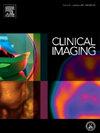特征追踪对PCI治疗急性心肌梗死患者左心室应变预后的影响:一项荟萃分析
IF 1.5
4区 医学
Q3 RADIOLOGY, NUCLEAR MEDICINE & MEDICAL IMAGING
引用次数: 0
摘要
目的通过荟萃分析,评价特征跟踪(FT)衍生的左心室(LV)应变参数对急性心肌梗死(AMI)患者预后的价值。材料和方法我们对PubMed、Embase和Cochrane图书馆2000年1月至2024年7月间发表的研究进行了全面检索,评估ft衍生的左室应变参数在预测AMI患者主要不良心血管事件(MACE)方面的预后价值。我们纳入了经皮冠状动脉介入治疗(PCI)再灌注后接受心脏磁共振特征跟踪分析的患者的研究,以及报告了总体纵向应变(GLS)或总体周向应变(GCS)的多变量分析。使用RStudio,我们使用随机效应模型计算95%置信区间(CI)的合并风险比(HR),并使用I2统计量评估异质性。结果纳入9项研究,共3651例患者。7项研究关注GLS, 5项研究评估GCS与MACE的关系。meta分析显示GLS与MACE发生之间存在显著相关性(HR 1.15;95% ci: 1.07-1.23;i2 = 76%;p≤0.0001)。对于GCS,合并HR为1.11 (95% CI: 1.04-1.19;i2 = 50%;p = 0.0024)。然而,一项遗漏敏感性分析显示,GCS对预后的影响并不稳健,合并风险比调整为1.09 (95% CI: 1.00-1.19)。结论ls是早期心肌损伤的敏感标志物,具有递增的预后价值,可能增强ami后患者的风险分层。相反,GCS没有显示出显著的预后影响。本文章由计算机程序翻译,如有差异,请以英文原文为准。
Prognostic impact of left ventricular strain by feature tracking in acute myocardial infarction treated with PCI: A meta-analysis
Purpose
To perform a meta-analysis to evaluate the prognostic value of feature tracking (FT)-derived left ventricular (LV) strain parameters in patients following acute myocardial infarction (AMI).
Materials and methods
We conducted a comprehensive search of PubMed, Embase, and the Cochrane library for studies published between January 2000 and July 2024, evaluating the prognostic value of FT-derived LV strain parameters in predicting major adverse cardiovascular events (MACE) in patients following AMI. We included studies of patients who underwent cardiac magnetic resonance feature tracking analysis following reperfusion by percutaneous coronary intervention (PCI), as well as reporting multivariate analyses of global longitudinal strain (GLS) or global circumferential strain (GCS). Using RStudio, we calculated pooled hazard ratios (HR) with 95 % confidence intervals (CI) using random-effects models and evaluated heterogeneity with I2 statistics.
Results
Nine studies involving 3651 patients were included. Seven studies focused on GLS, while five evaluated GCS in relation to MACE. The meta-analysis revealed a significant association between GLS and MACE occurrence (HR 1.15; 95 % CI: 1.07–1.23; I2 = 76 %; p ≤ 0.0001). For GCS, the pooled HR was 1.11 (95 % CI: 1.04–1.19; I2 = 50 %; p = 0.0024). However, a leave-one-out sensitivity analysis showed that the prognostic effect of GCS was not robust, as the pooled HR adjusted to 1.09 (95 % CI: 1.00–1.19).
Conclusion
GLS was identified as a sensitive marker of early myocardial injury with incremental prognostic value, potentially enhancing risk stratification for post-AMI patients. Conversely, GCS did not demonstrate a significant prognostic effect.
求助全文
通过发布文献求助,成功后即可免费获取论文全文。
去求助
来源期刊

Clinical Imaging
医学-核医学
CiteScore
4.60
自引率
0.00%
发文量
265
审稿时长
35 days
期刊介绍:
The mission of Clinical Imaging is to publish, in a timely manner, the very best radiology research from the United States and around the world with special attention to the impact of medical imaging on patient care. The journal''s publications cover all imaging modalities, radiology issues related to patients, policy and practice improvements, and clinically-oriented imaging physics and informatics. The journal is a valuable resource for practicing radiologists, radiologists-in-training and other clinicians with an interest in imaging. Papers are carefully peer-reviewed and selected by our experienced subject editors who are leading experts spanning the range of imaging sub-specialties, which include:
-Body Imaging-
Breast Imaging-
Cardiothoracic Imaging-
Imaging Physics and Informatics-
Molecular Imaging and Nuclear Medicine-
Musculoskeletal and Emergency Imaging-
Neuroradiology-
Practice, Policy & Education-
Pediatric Imaging-
Vascular and Interventional Radiology
 求助内容:
求助内容: 应助结果提醒方式:
应助结果提醒方式:


